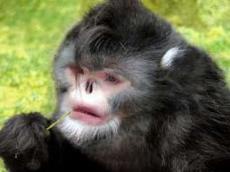|
|
TODAY.AZ / Weird / Interesting
Would you like to meet new species we never knew existed until now? – PHOTOS
24 May 2012 [14:16] - TODAY.AZ
 They include a bearded monkey that sneezes when it rains, a bright blue tarantula and a millipede the size of a sausage. All are among the top ten weird and wonderful creatures which until last year were unknown to science.
They include a bearded monkey that sneezes when it rains, a bright blue tarantula and a millipede the size of a sausage. All are among the top ten weird and wonderful creatures which until last year were unknown to science.They were discovered mainly in remote parts of the world rarely visited by humans.
The top ten were picked from more than 200 nominated new species by an international committee which hopes to draw attention to the plight of wildlife.
They are an intriguing bunch…and none more so than the monkey with a thick white beard, whose nose is so upturned it gets an attack of sneezes when it rains.
Discovered by Cambridge University scientists high in the mountains of Burma, there are thought to be fewer than 300 left. They spend rainy days hiding their heads between their knees.
From the other side of the world comes the Tamoya ohboya – a jellyfish with long red-and-white tails like a box kite. Found near the Dutch island of Bonaire off the coast of Venezuela, the name comes from the exclamation of those it stings – ‘Oh boy!’.
The Devil’s Worm has won the accolade of the deepest-living complex organism on the planet. Just half a millimetre long – a 50th of an inch – it was found in a South African gold mine nearly a mile deep where the temperature is 37C (99F).
Other wonders include Sazima’s tarantula, an iridescent blue spider found in Brazil; a tiny wasp from Spain nicknamed the ‘dive bomber’ which flies just half an inch above the ground to prey on ants, a fungus found in Borneo which looks like a bathroom sponge, and a giant millipede found in Tanzania.
Other plants which made the list include an orchid from Papua New Guinea discovered by scientists from Kew Gardens in London. It blooms at around 10pm and closes its petals again in the morning.
The list has been compiled for the last five years on the birthday of Carolus Linnaeus, the 18th century Swedish botanist who created the modern system of plant and animal names and classification.
Professor Quentin Wheeler, of the International Institute for Species Exploration at Arizona State University said dozens of ‘unsung’ species are discovered by explorers and museums every year.
He said: ‘The more species we discover, the more amazing the biosphere proves to be.’
Scientists estimate there are about nine million species of plants and animals on Earth, but as little as 10 per cent have been classified.
/dailymail.co.uk/
URL: http://www.today.az/news/interesting/107632.html
 Print version
Print version
Views: 1824
Connect with us. Get latest news and updates.
See Also
- 06 December 2024 [22:20]
Are scented candles harmful to health? - 23 November 2024 [14:11]
Magnitude 4.5 earthquake hits Azerbaijan's Lachin - 20 November 2024 [23:30]
Launch vehicle with prototype of Starship made its sixth test flight - 27 October 2024 [09:00]
Fuel prices expected to rise in Sweden - 24 October 2024 [19:14]
Turkiye strikes terror targets in Iraq and Syria - 23 October 2024 [23:46]
Kazakhstan supplied almost entire volume of oil planned for 2024 to Germany in 9 months - 23 October 2024 [22:17]
Taiwan reported passage of Chinese Navy aircraft carrier near island - 23 October 2024 [21:50]
Russia remains largest oil supplier to India - 16 October 2024 [17:54]
Gamesummit co-founder shares insights on future of gaming industry in Azerbaijan [EXCLUSIVE] - 12 October 2024 [18:27]
TikTok cuts jobs, turns to AI for content moderation
Most Popular
 Battle for the Caucasus: Azerbaijan needs a stable Georgia
Battle for the Caucasus: Azerbaijan needs a stable Georgia
 IDPs return to rebuilt Shusha as part of Great Return State Program
IDPs return to rebuilt Shusha as part of Great Return State Program
 Azerbaijani delegation attends "Vietnam Defence Expo 2024" in Hanoi
Azerbaijani delegation attends "Vietnam Defence Expo 2024" in Hanoi
 West has no interest in him: the United States has disowned Vardanyan
West has no interest in him: the United States has disowned Vardanyan
 Azerbaijan participates in 11th D8 Economic Cooperation Organization summit
Azerbaijan participates in 11th D8 Economic Cooperation Organization summit
 Minister Bolat highlights Turkiye's economic growth and trade achievements
Minister Bolat highlights Turkiye's economic growth and trade achievements
 Azerbaijan, Russia inks agreement on Development of Transit Freight Transportation
Azerbaijan, Russia inks agreement on Development of Transit Freight Transportation












